Subgenus Rhamnus Higher classification Buckthorn | Genus Rhamnus Scientific name Rhamnus cathartica Rank Species | |
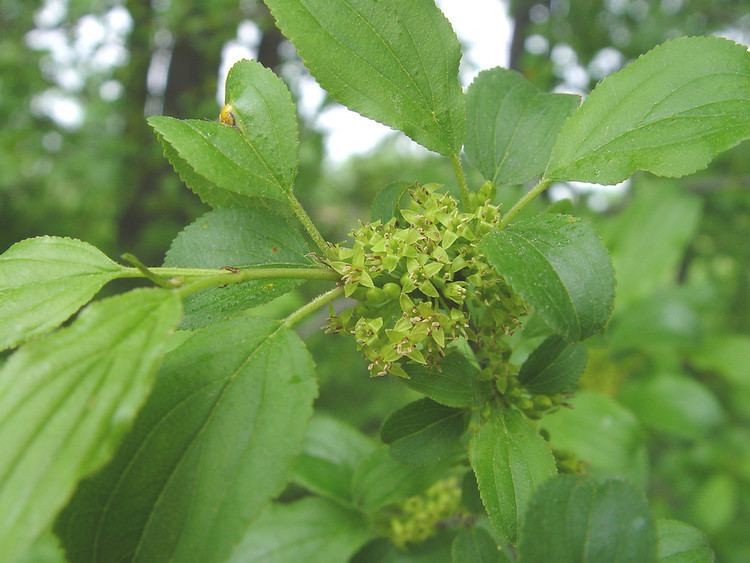 | ||
Similar Buckthorn, Frangula alnus, Rhamnaceae, Euonymus europaeus, Cornus sanguinea | ||
Rhamnus cathartica
Rhamnus cathartica, the buckthorn, common buckthorn or purging buckthorn, is a species of small tree in the flowering plant family Rhamnaceae. It is native to Europe, northwest Africa and western Asia, from the central British Isles south to Morocco, and east to Kyrgyzstan. It was introduced to North America as an ornamental shrub in the early 19th century or perhaps before, and is now naturalized in the northern half of the continent, and is classified as an invasive plant in several US states and in Ontario, Canada.
Contents
- Rhamnus cathartica
- Killing a big buckthorn rhamnus cathartica a highly invasive tree or shrub
- Description
- Toxicity
- Ecology
- Allelopathy
- In North America
- Uses
- Control methods
- References
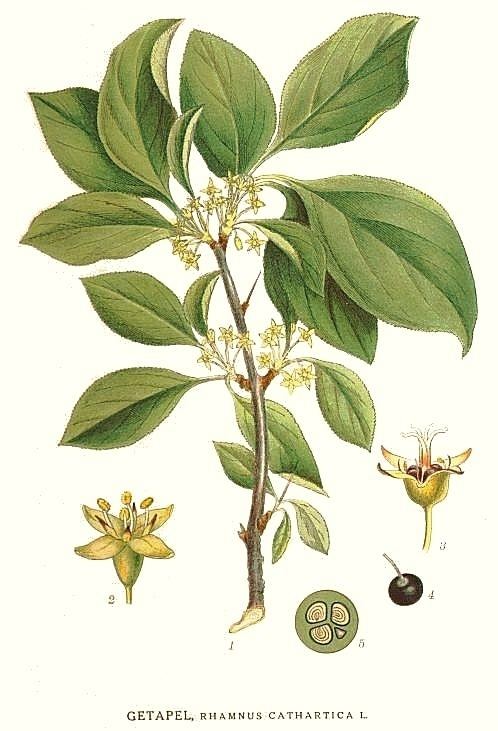
Killing a big buckthorn rhamnus cathartica a highly invasive tree or shrub
Description
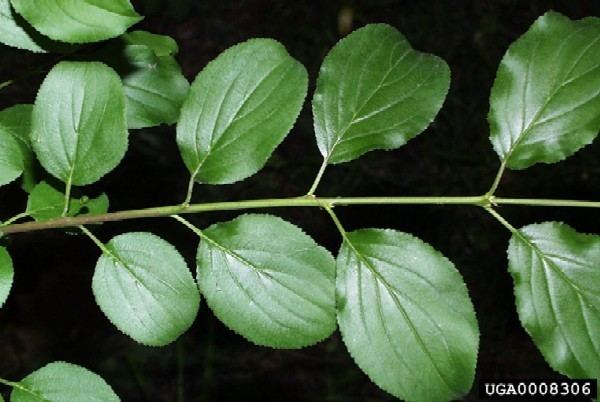
Rhamnus cathartica is a deciduous shrub or small tree growing up to 10 metres (33 ft) tall, with grey-brown bark and spiny branches. The leaves are elliptic to oval, 25–90 mm (1–3 1⁄2 in) long and 12–35 mm (1⁄2–1 3⁄8 in) broad; they are green, turning yellow in autumn, and are arranged somewhat variably in opposite to subopposite pairs or alternately. The flowers are yellowish-green, with four petals; they are dioecious and insect pollinated. The fruit is a globose black drupe, 6–10 mm (1⁄4–3⁄8 in) across, and contains two to four seeds.

The species was originally named by Carl Linnaeus as Rhamnus catharticus, but this spelling was corrected to cathartica as the genus name Rhamnus is treated as being of feminine gender.
Toxicity

The seeds and leaves are mildly poisonous for people and animals, but are readily eaten by birds, which disperse the seeds in their droppings. The toxins cause stomach cramps and laxative effects that may function in seed dispersal. The chemical compounds responsible for this laxative effect are anthraquinone and emodin. The species name cathartica and the common name purging buckthorn refer to this effect.
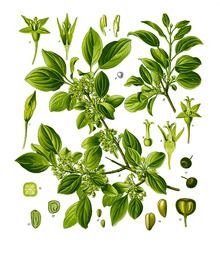
In 1994, R. cathartica was implicated in the outbreak of an idiopathic neurological disease in horses, although no causative agent was officially identified. In trials where rodents were fed the leaves and stems of R. cathartica, glycogen metabolism became abnormal and glycogen deposits formed in the cytoplasm of liver cells. Abnormalities in glycogen metabolism lead to diabetes in humans.
Ecology
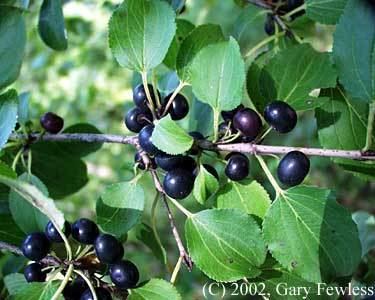
Rhamnus cathartica is shade-tolerant, moderately fast-growing and short-lived. It is a food plant of the brimstone butterfly, Gonepteryx rhamni. The sulphur-yellow males are indicative of the presence of this species or of its alternative host, Frangula alnus.
This species is the alternate host for the important rust disease of cereals caused by Puccinia coronata. Rhamnus cathartica is also the primary overwintering host in North America for an important agricultural pest of soybeans, the soybean aphid.
Allelopathy
Secondary compounds, particularly emodin, have been found in the fruit, leaves, and bark of the plant, and may protect it from insects, herbivores and pathogens. The emodin present in R. cathartica fruit may prevent early consumption, as it is found most in unripe fruits, which allows seeds to reach maturity before being dispersed. Birds and mice significantly avoid eating unripe fruits, and if forced to ingest emodin or unripe fruit, the animals regurgitate the meal or produce loose, watery stools.
Allelopathic effects of exudates from R. cathartica leaf litter, roots, bark, leaves and fruit may reduce germination of other plant species in the soil. Soils in buckthorn-dominated areas are higher in nitrogen and carbon than normal soils, which speeds up decomposition rates of leaf litter. This can result in bare patches of soil being formed and R. cathartica performs well in such disturbed habitats, so this may be adaptive for the setting of its seed.
In North America
The species is naturalised and invasive in parts of North America. Rhamnus cathartica has a competitive advantage over native trees and shrubs in North America because it leafs out before native species. Of the annual carbon gain in R. cathartica, 27-35% comes from photosynthesis occurring before the leaves of other plants emerge. Soil in woodlands dominated by R. cathartica was higher in nitrogen, pH and water content than soil in woodlands relatively free of R. cathartica, probably because R. cathartica has high levels of nitrogen in its leaves and these leaves decompose rapidly.
Rhamnus cathartica is also associated with invasive European earthworms (Lumbricus spp.) in the northern Midwest of North America. Removing R. cathartica led to a decrease of around 50% in the biomass of invasive earthworms.
Uses
The bark and fruit of Rhamnus catharticus were used as a purgative in the past, although their potentially dangerous violent action and side-effects means they are now rarely used. The wood is hard and dense, but little-used.
Control methods
Rhamnus catharticus is difficult to control in its invasive range, because it sprouts vigorously and repeatedly from the root collar following cutting, girdling or burning. Herbicide application to newly cut stumps is a popular and effective control method, but seeds stay viable in the soil for several years before sprouting, so repeated treatments and long-term monitoring of infested areas is required. Garlon and Tordon and their derivatives have been found to be effective chemical means of control. Roundup can be used but is less reliable. An application of these chemicals in early winter reduces the risk of negatively affecting non-target species, as most have gone dormant by this time. It is also easier to spot infestations at this time of the year, as the leaves of R. catharticus stay out an average of 58 days longer than native plants.
Mechanical control methods such as pulling and chopping of plants are more environmentally friendly, but also very time-consuming. Plants with stems less than half an inch in diameter or less than a metre tall can easily be pulled, but pulling risks disturbing the roots of adjacent, native plants and harming them as well. Propane weed-torches may also be used to kill seedlings, which will generally not resprout if burned in spring or early summer.
